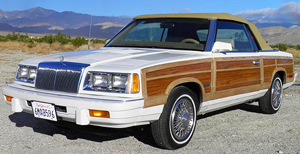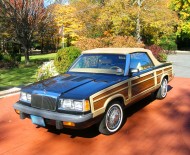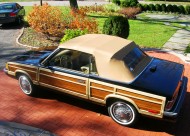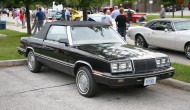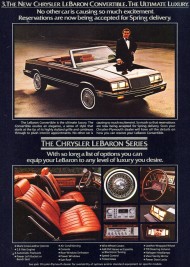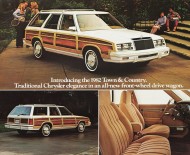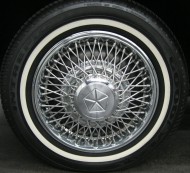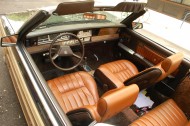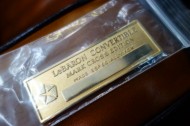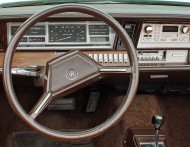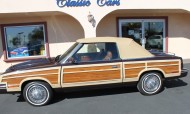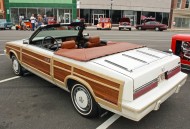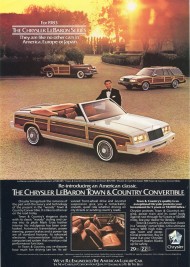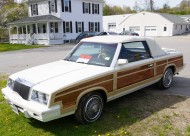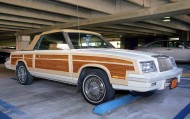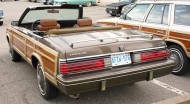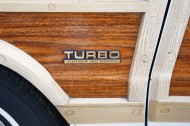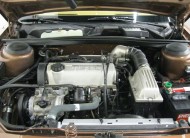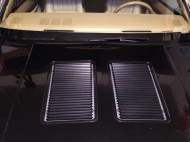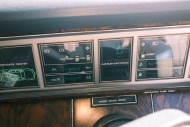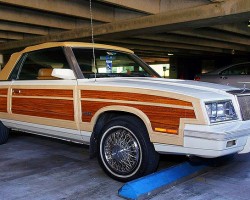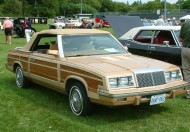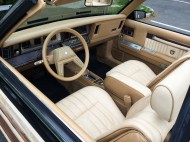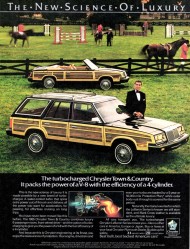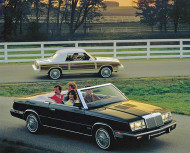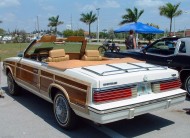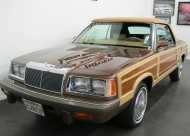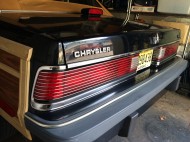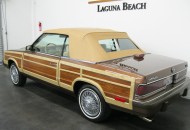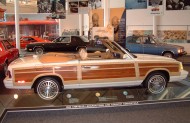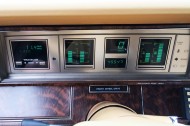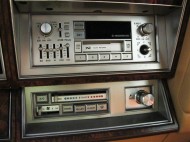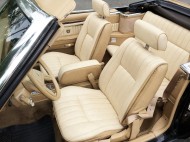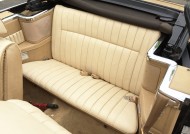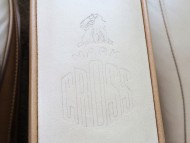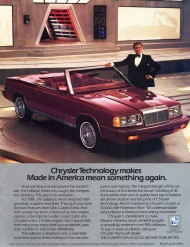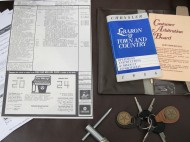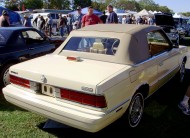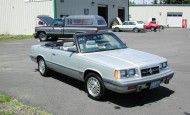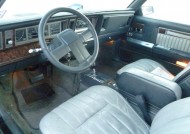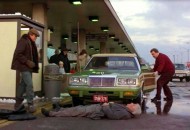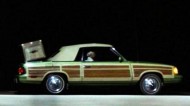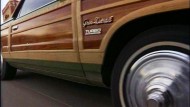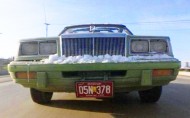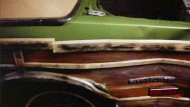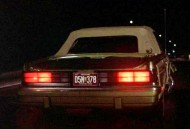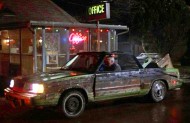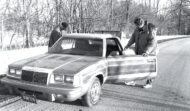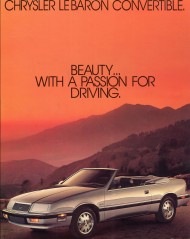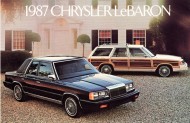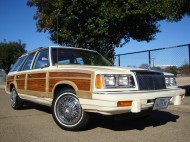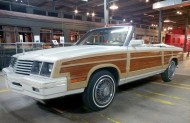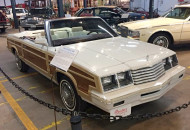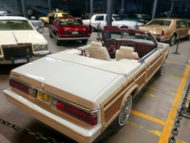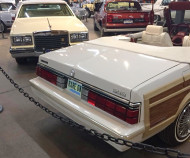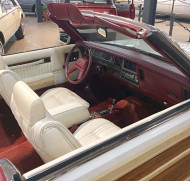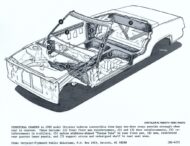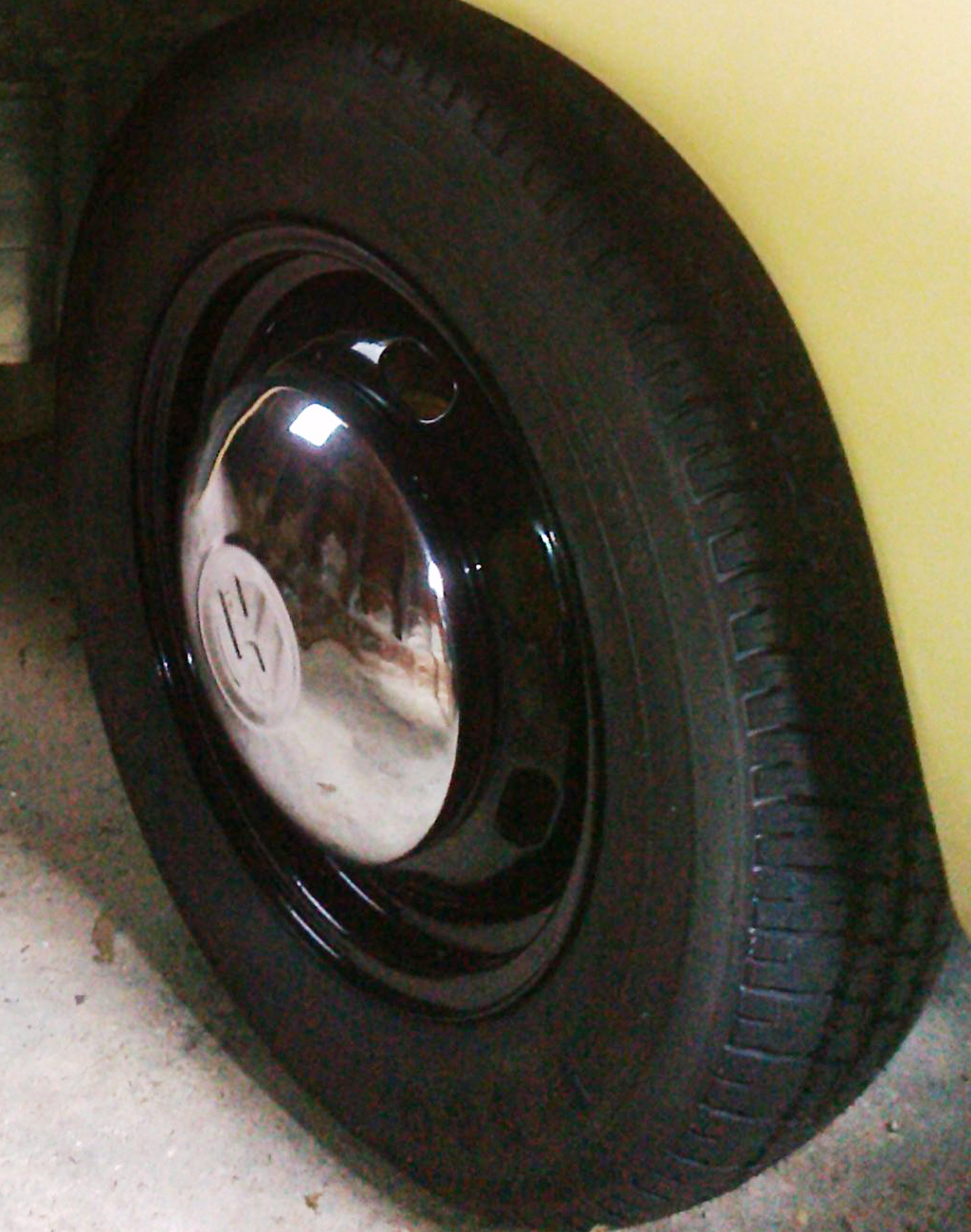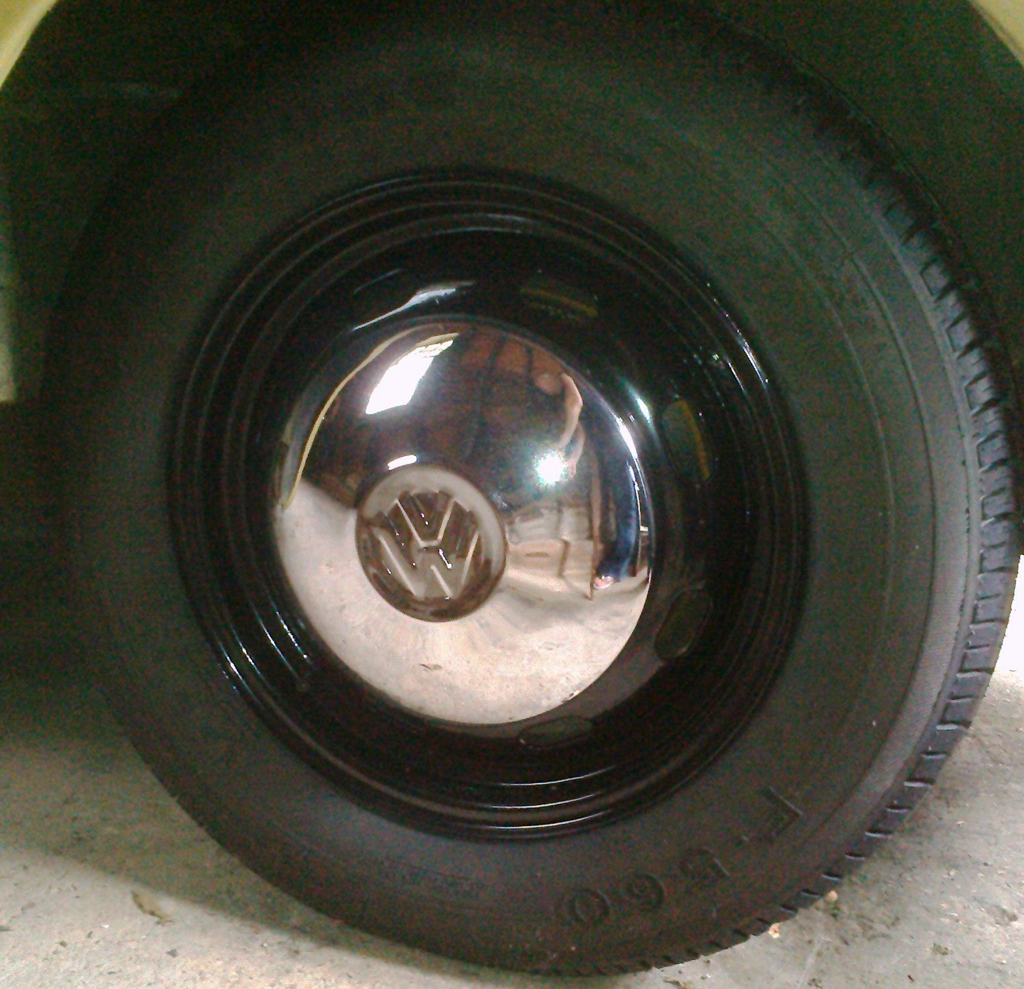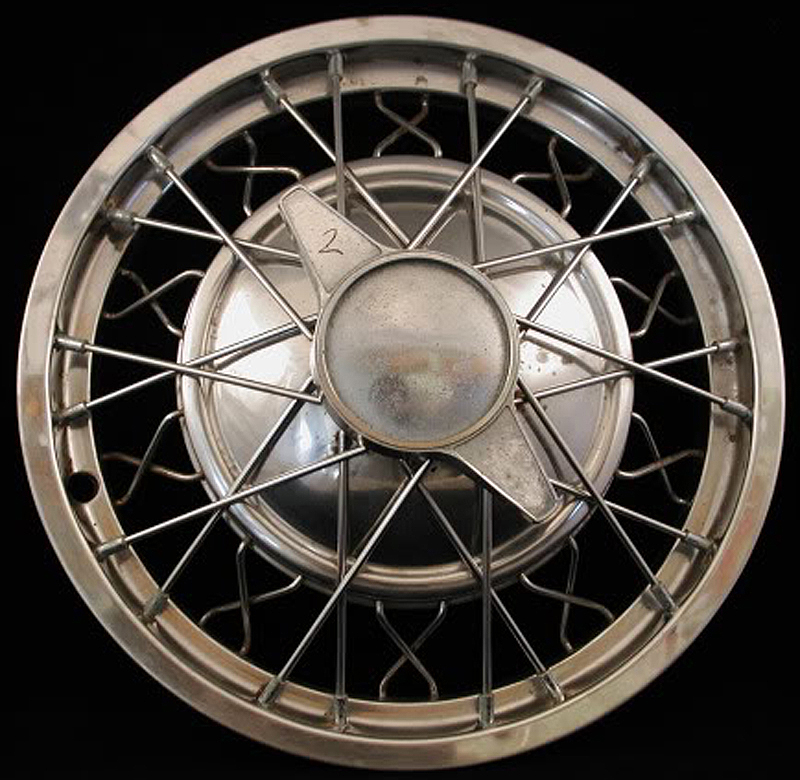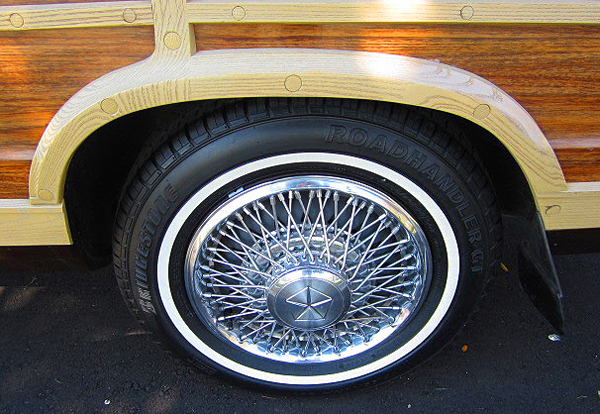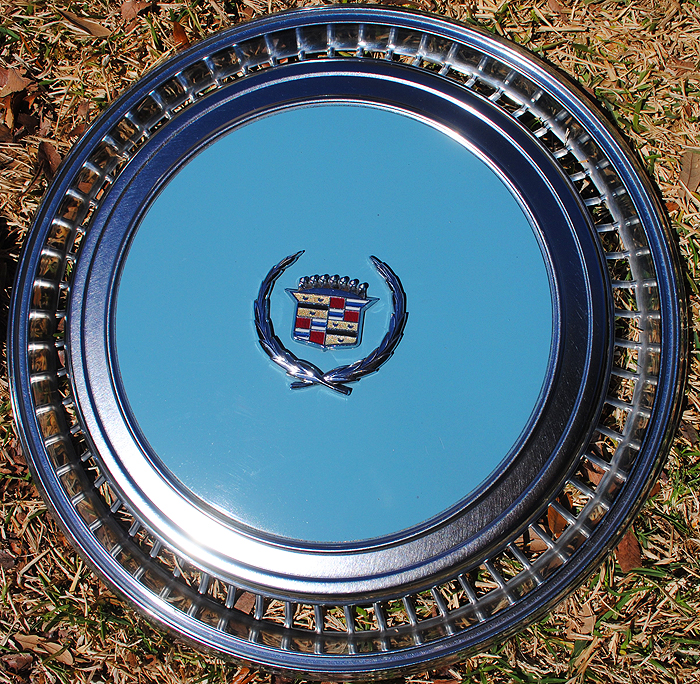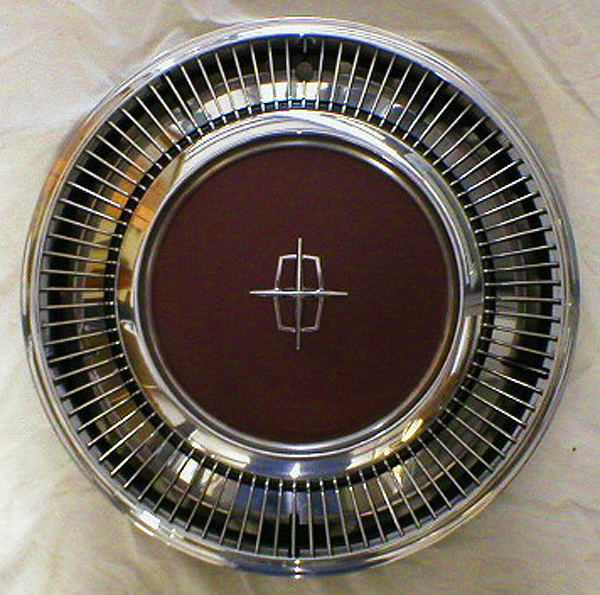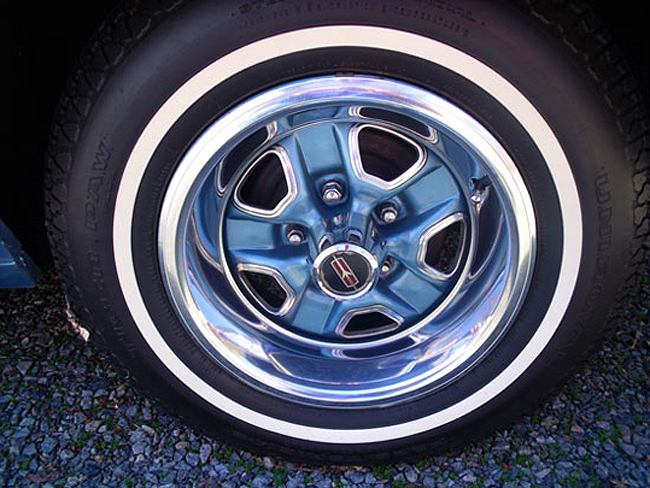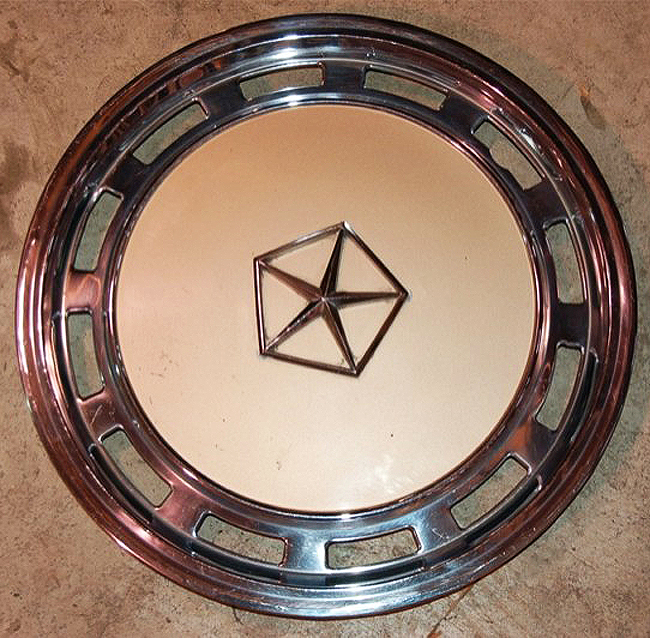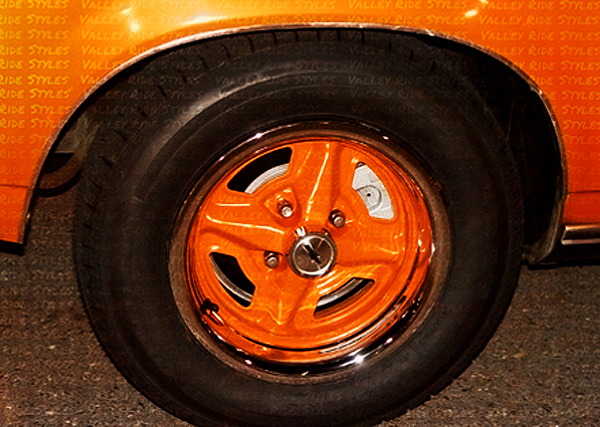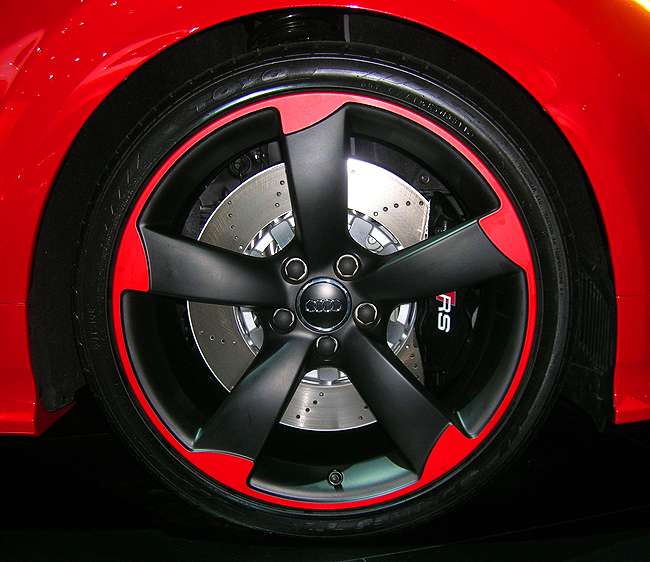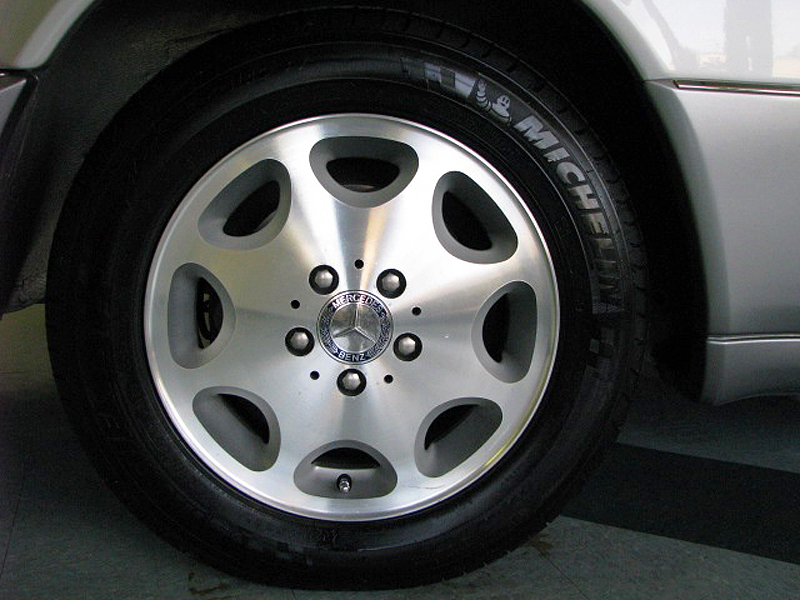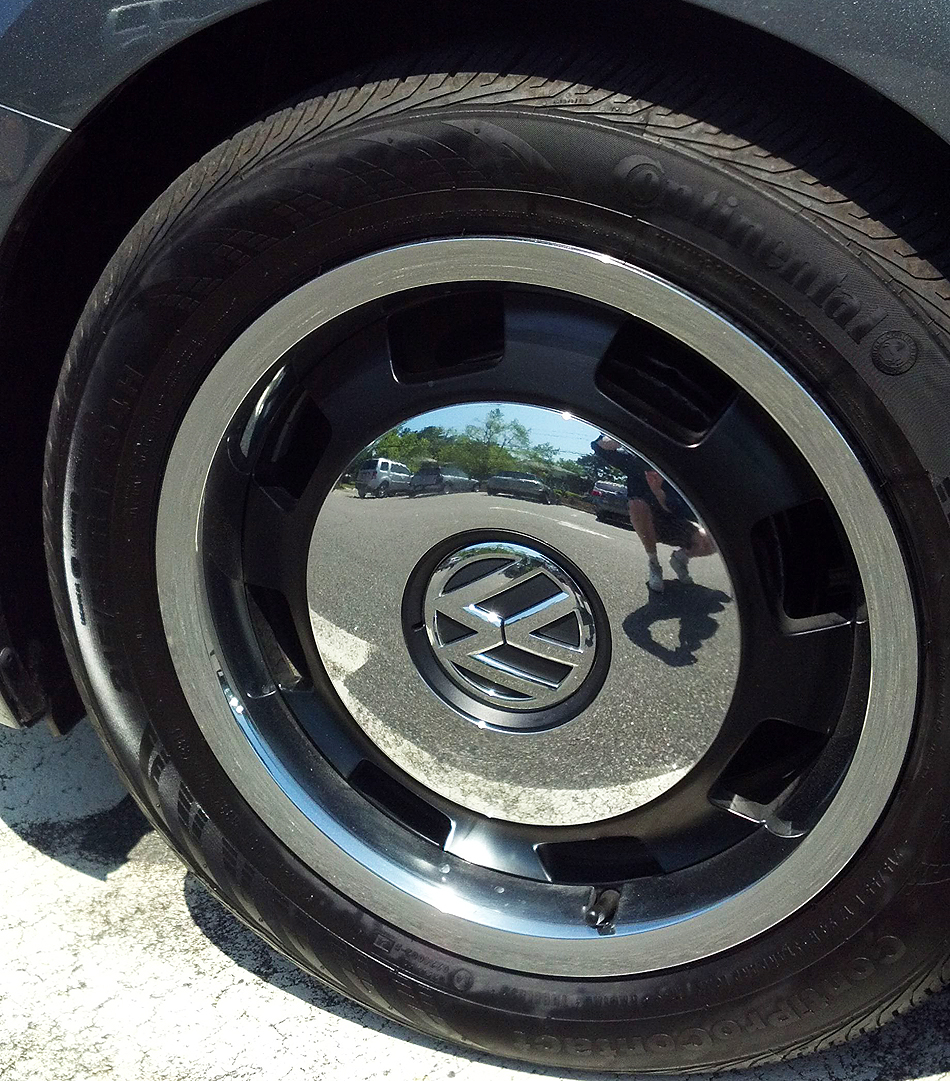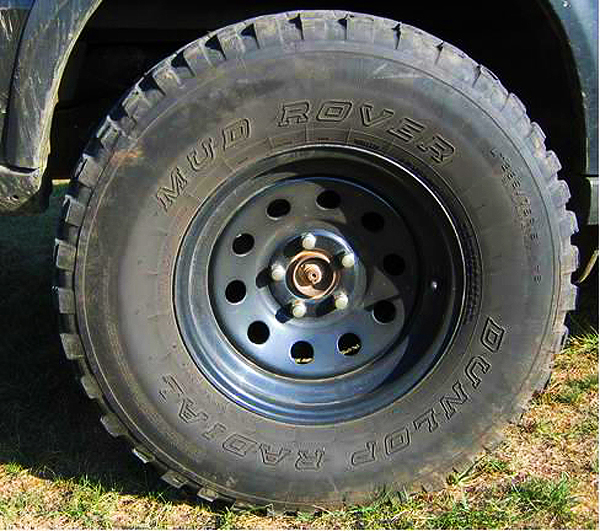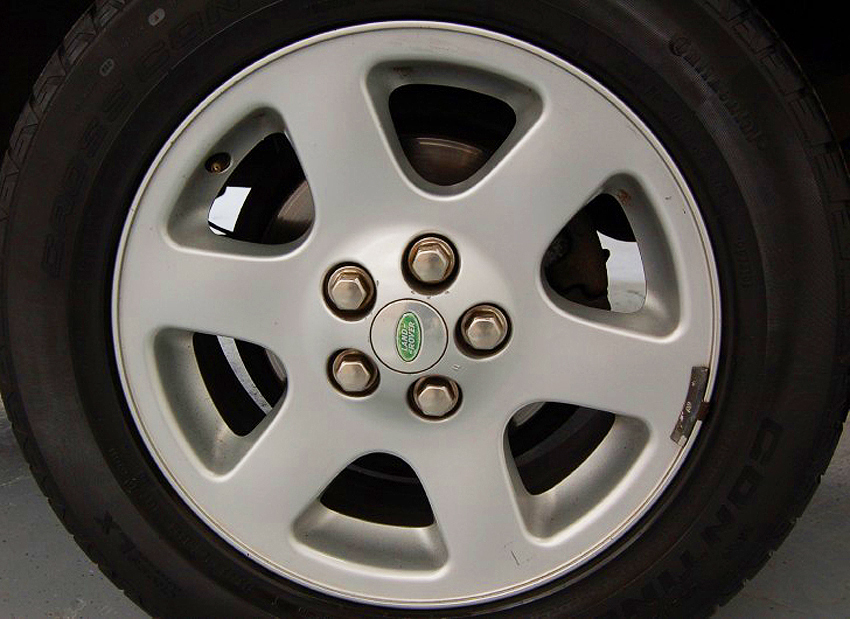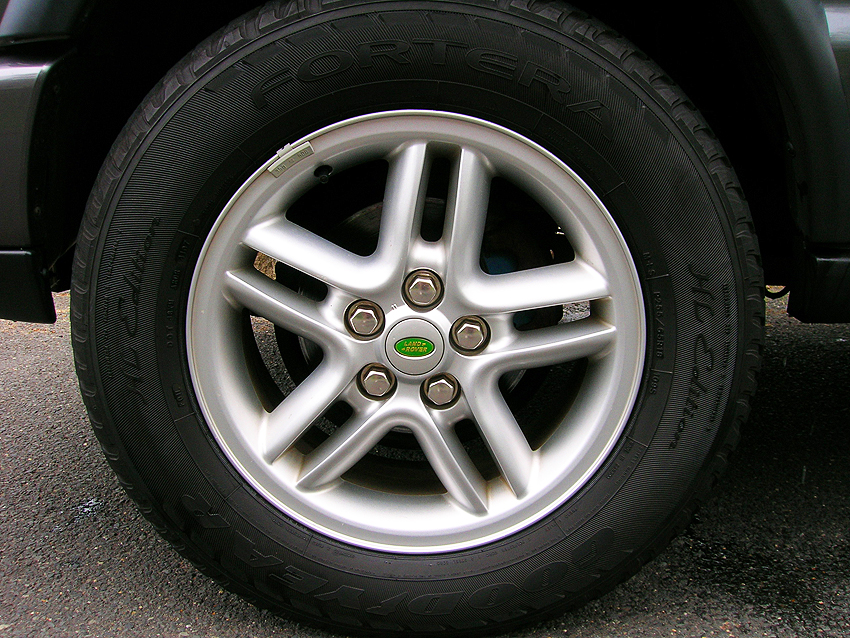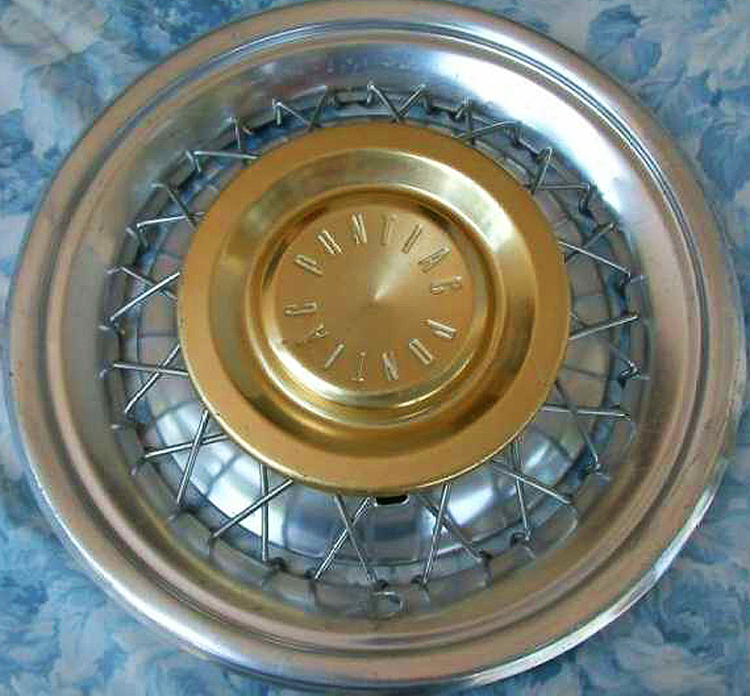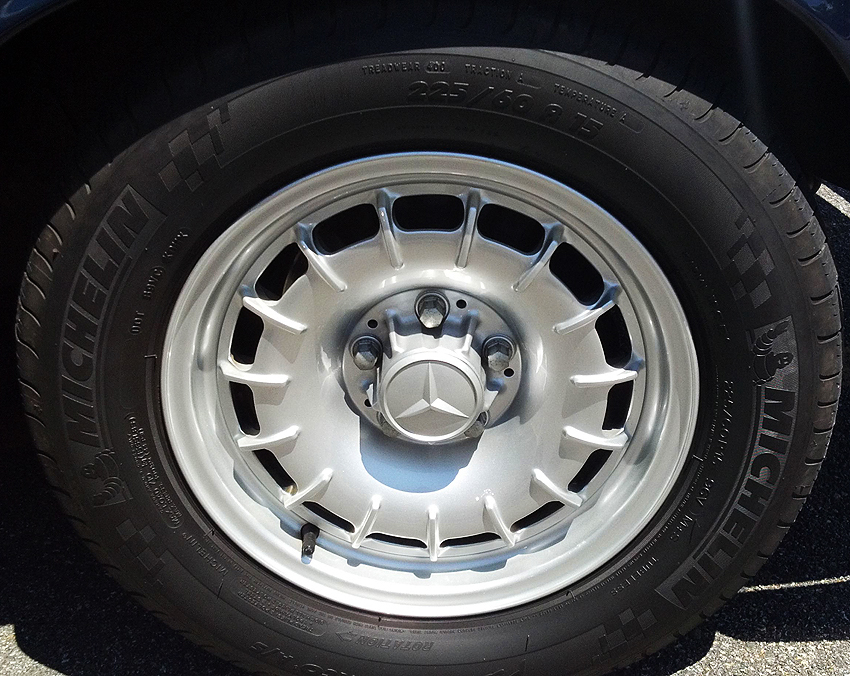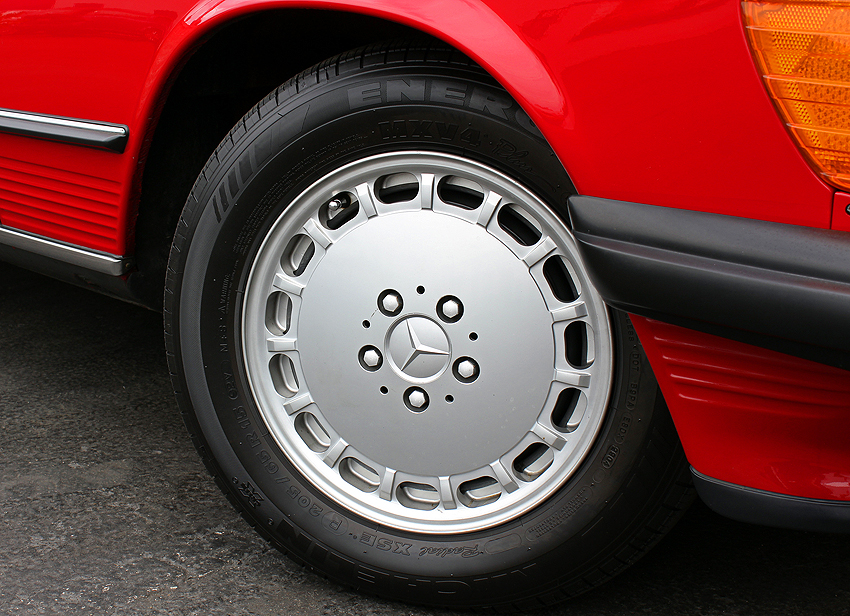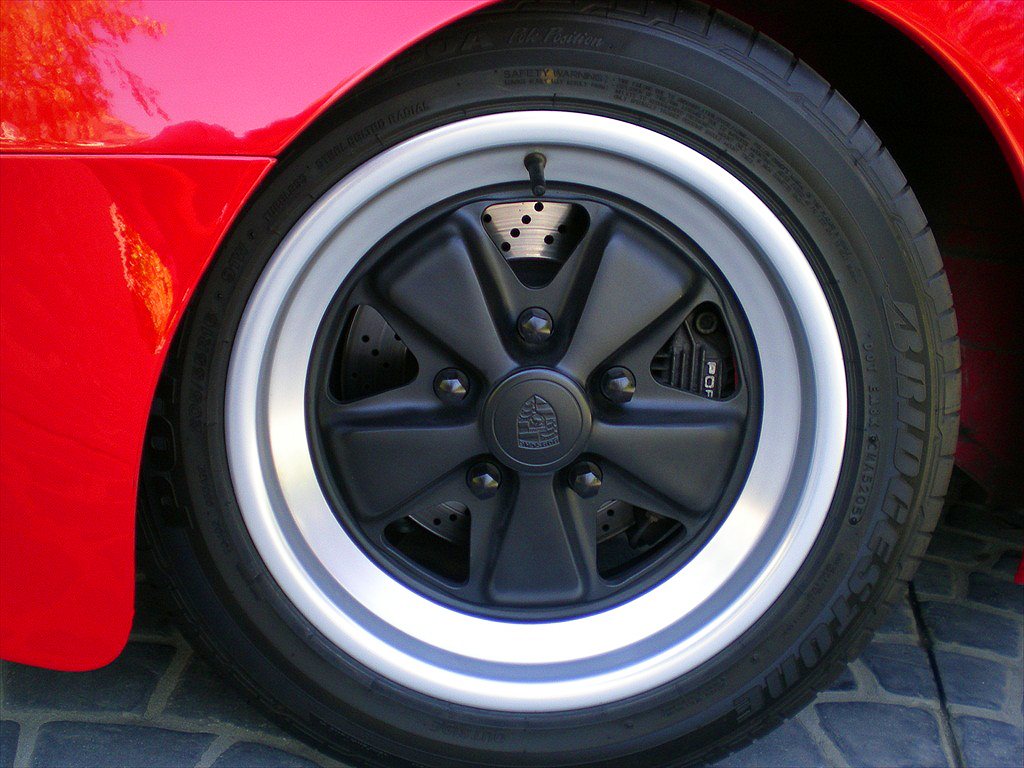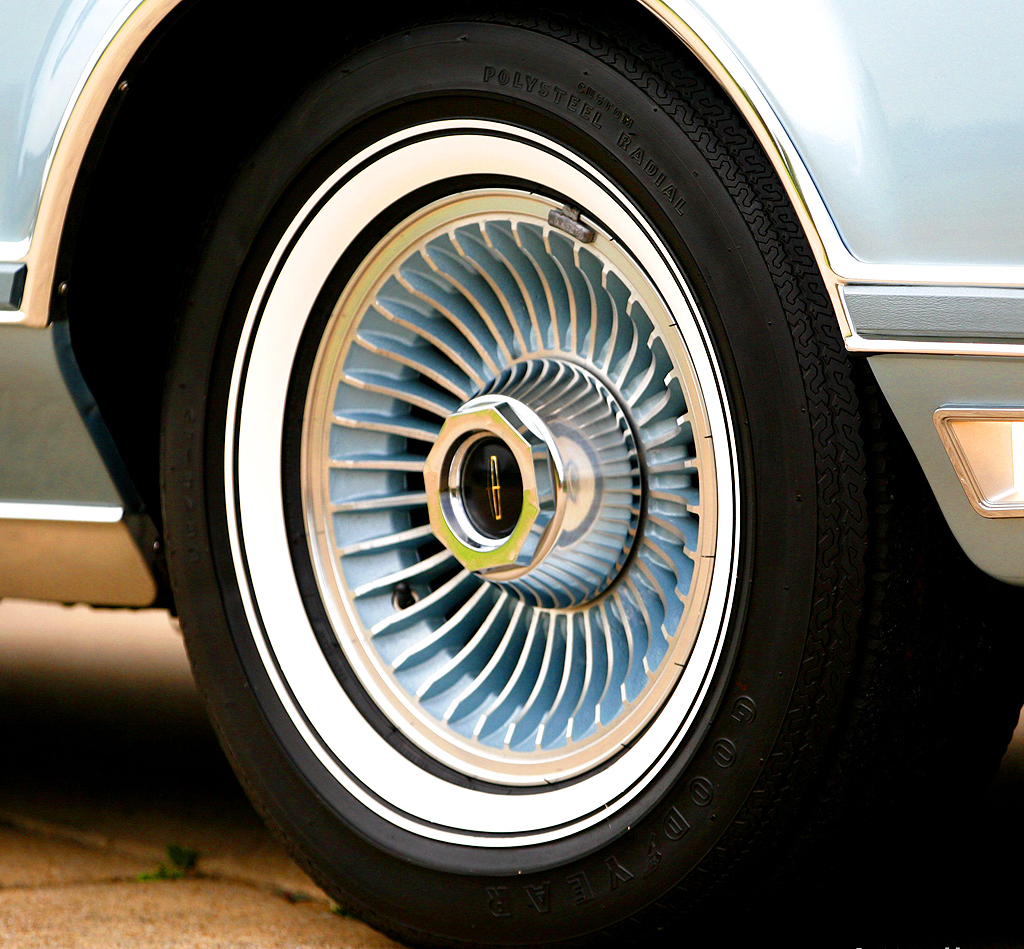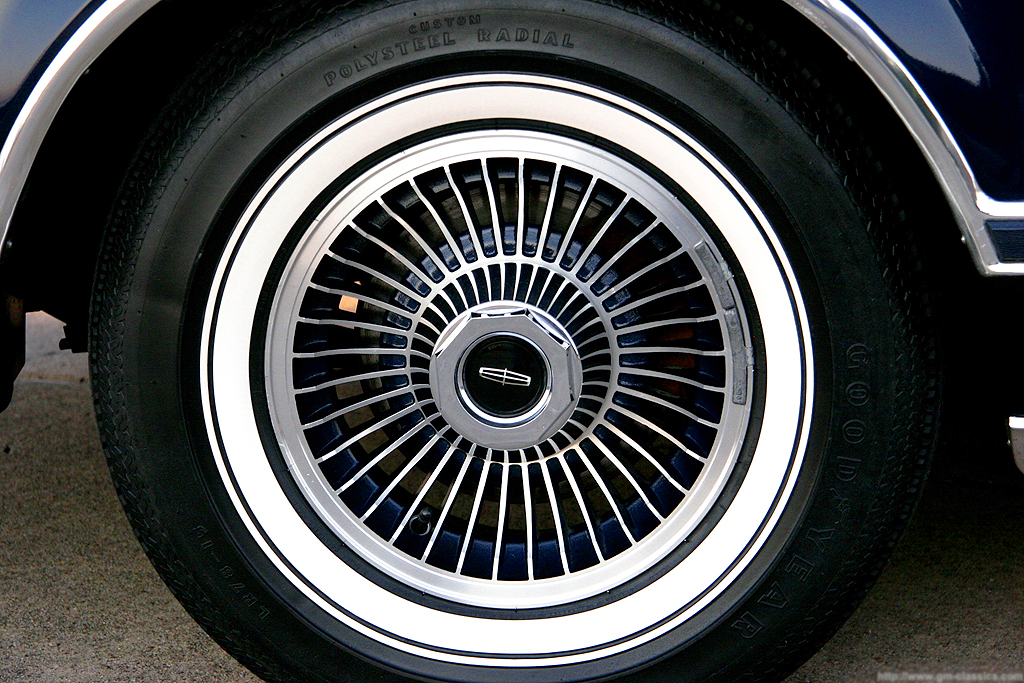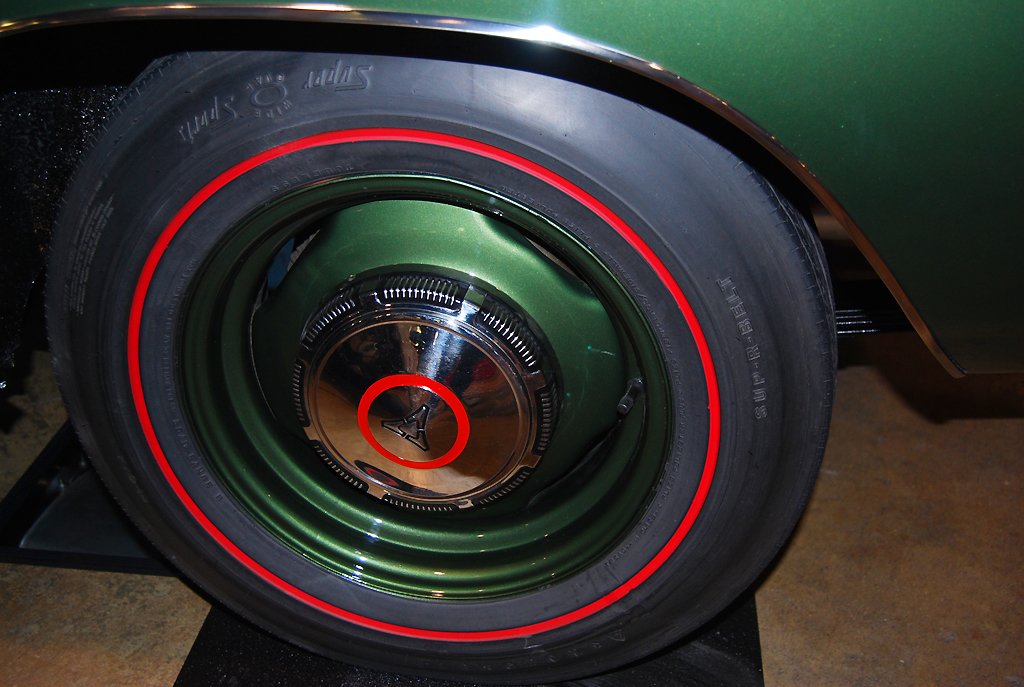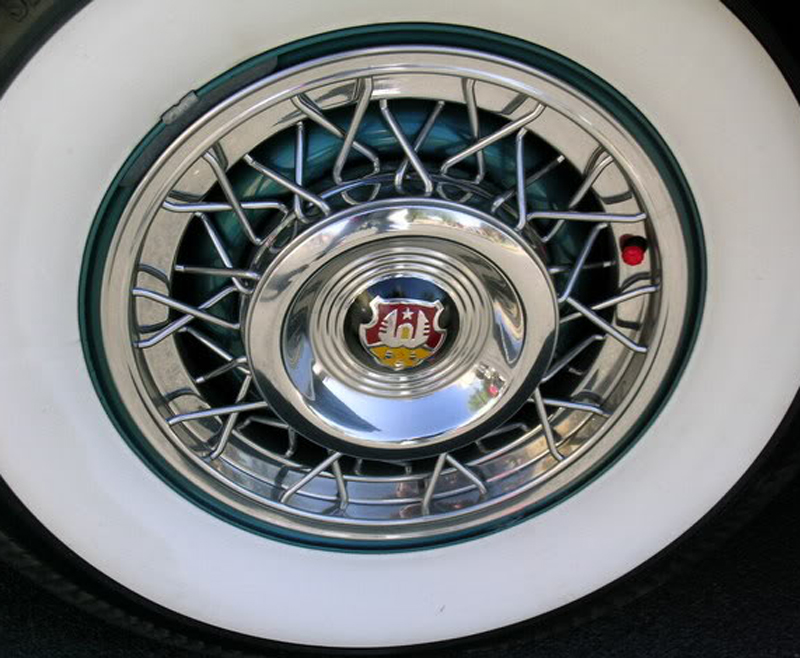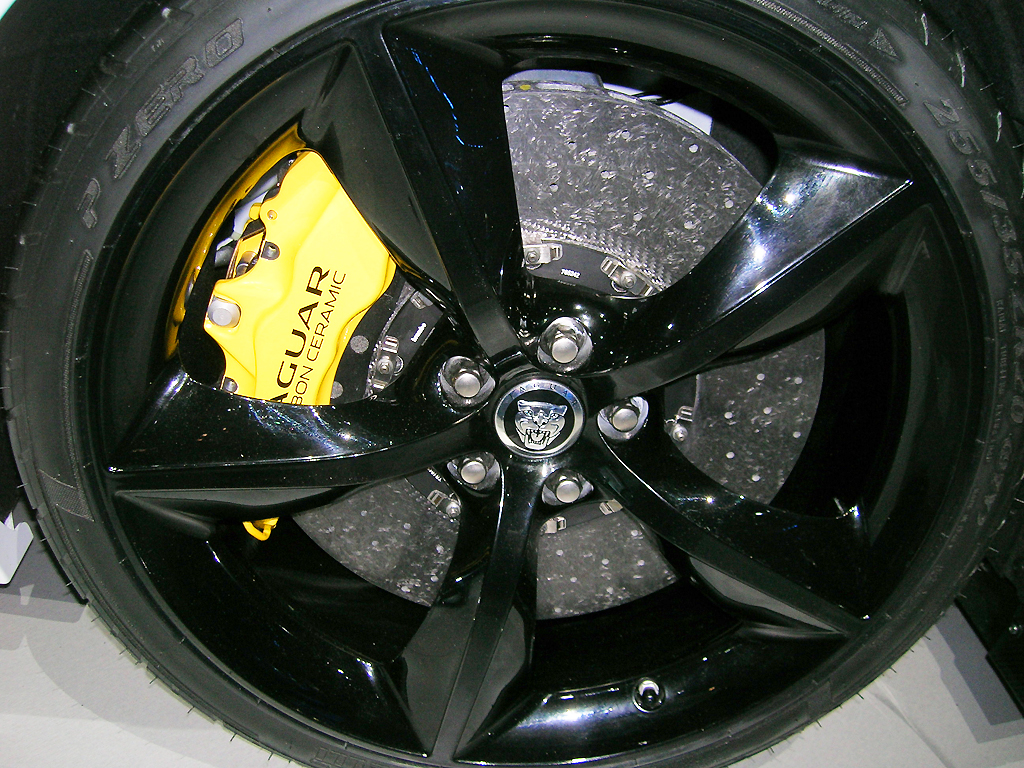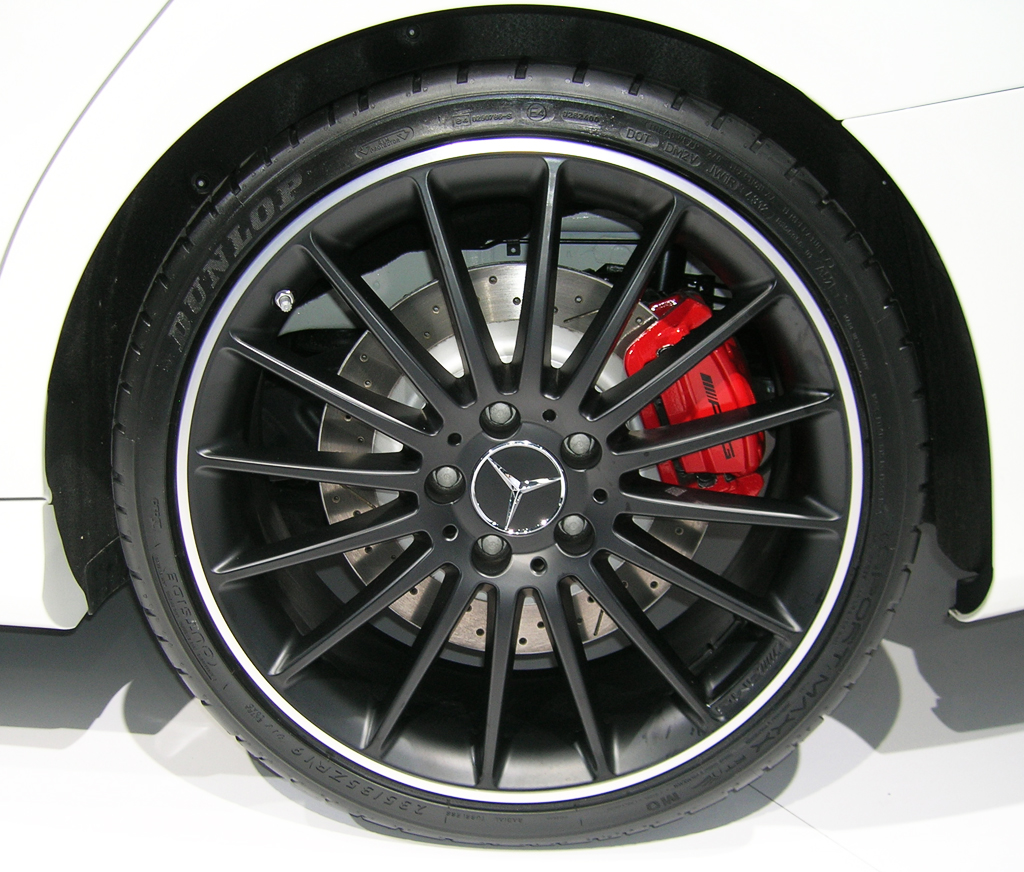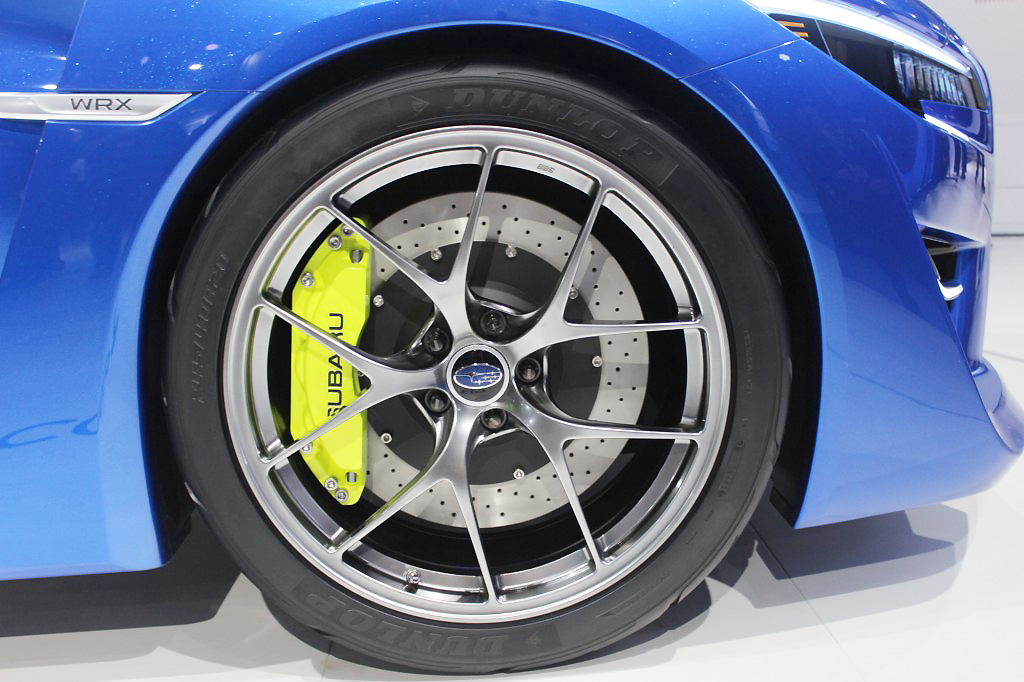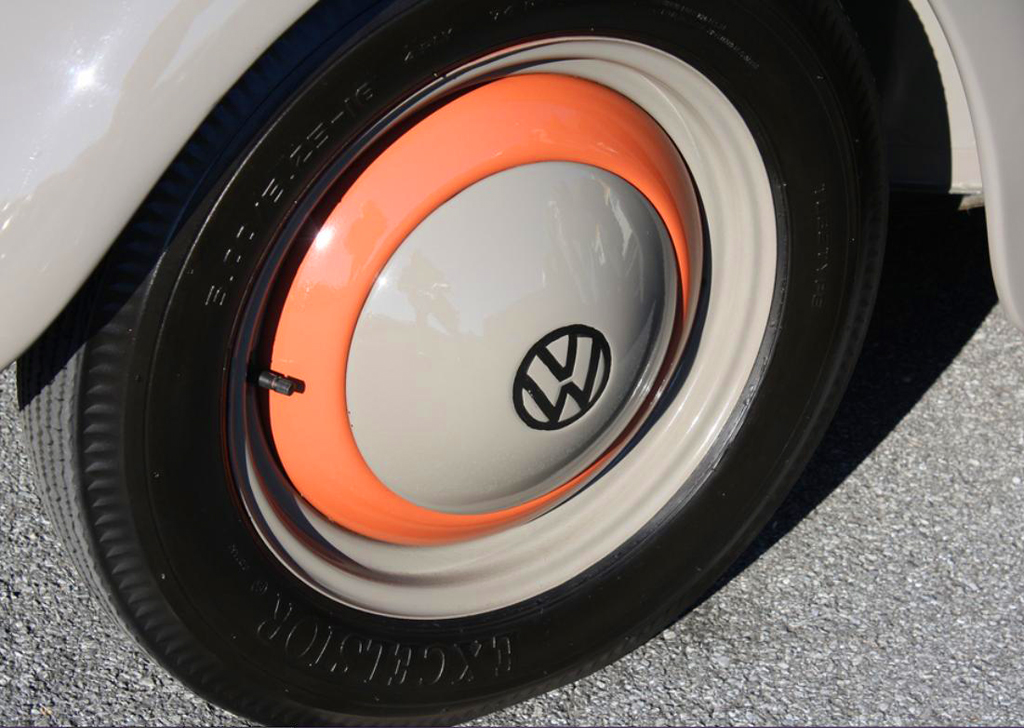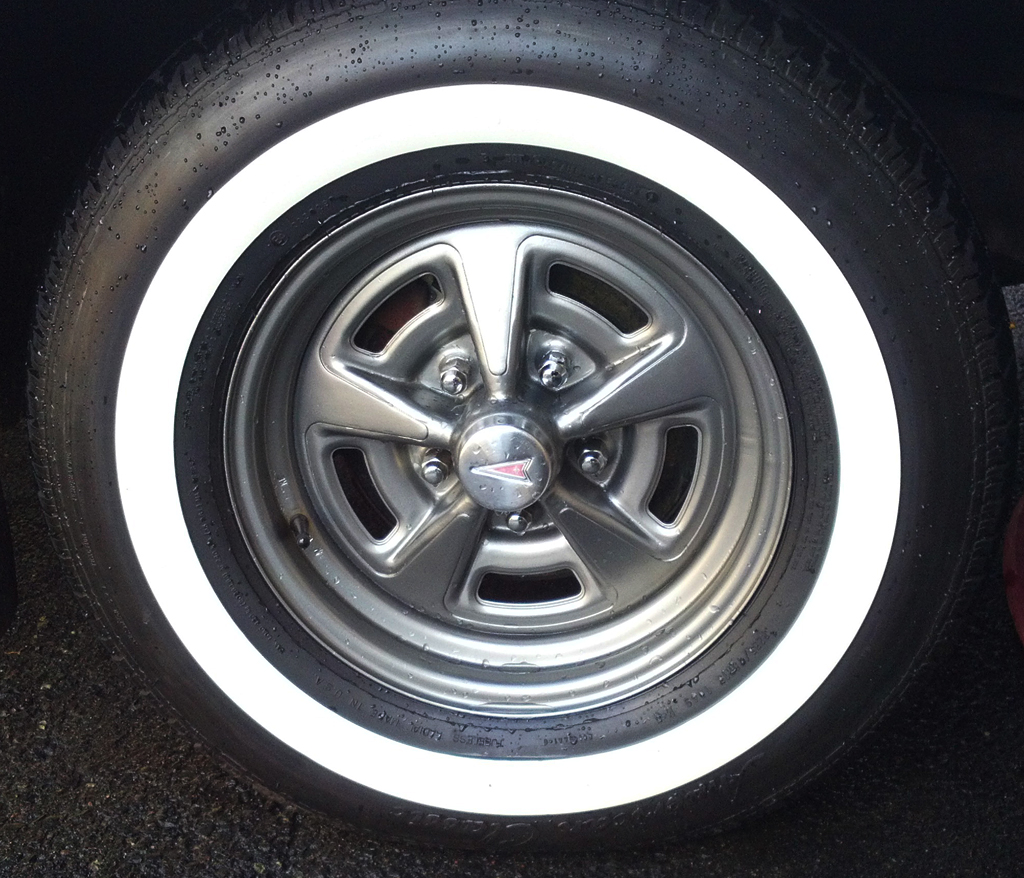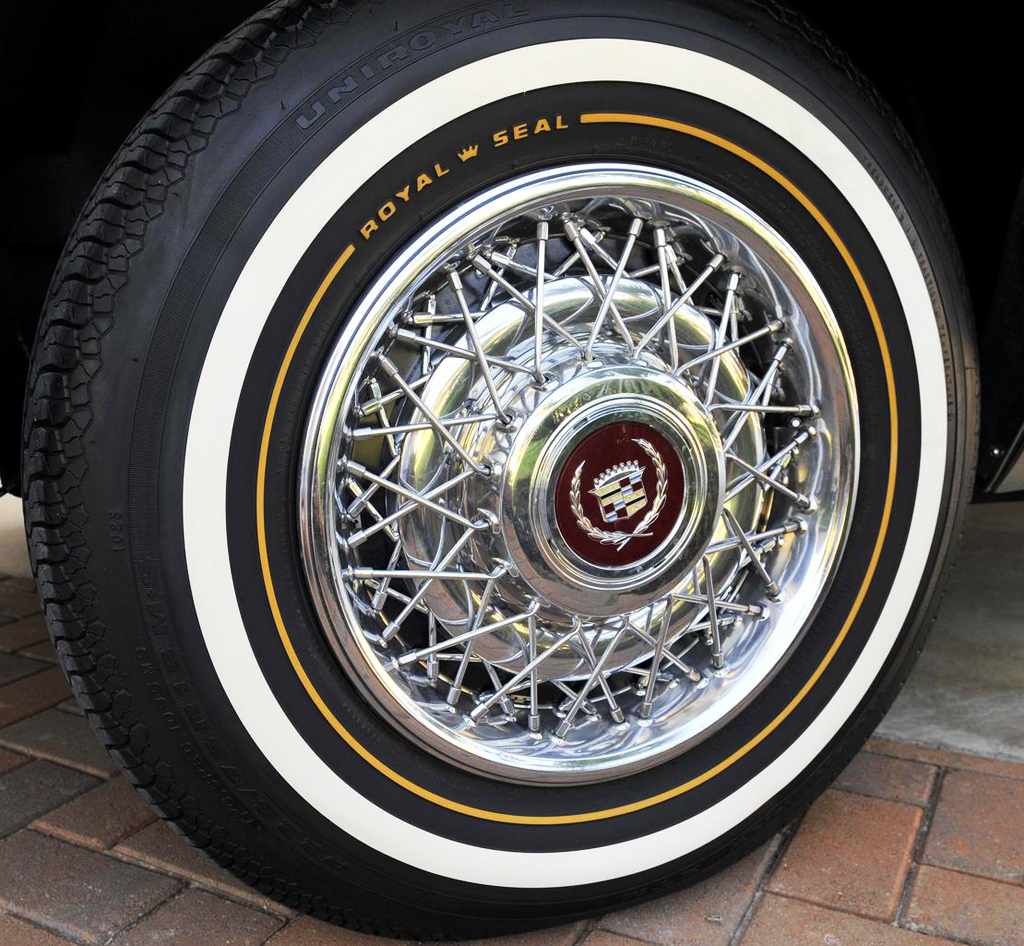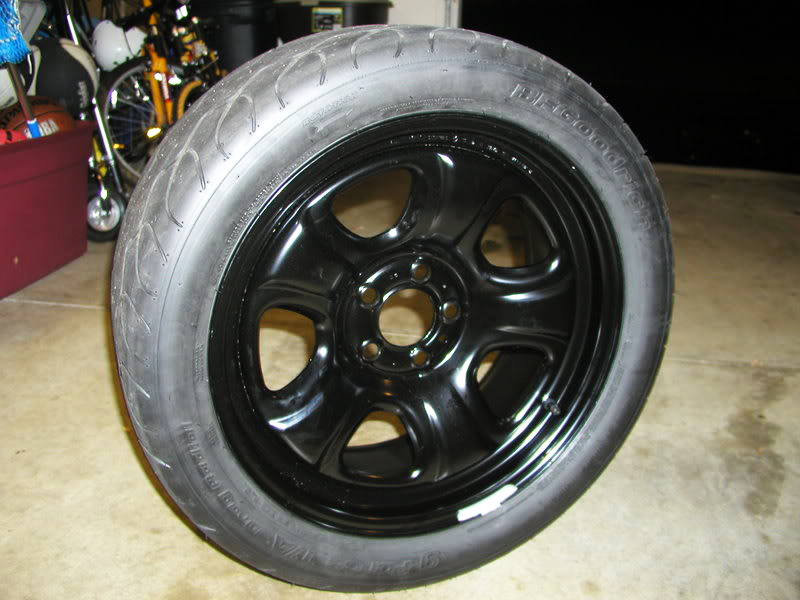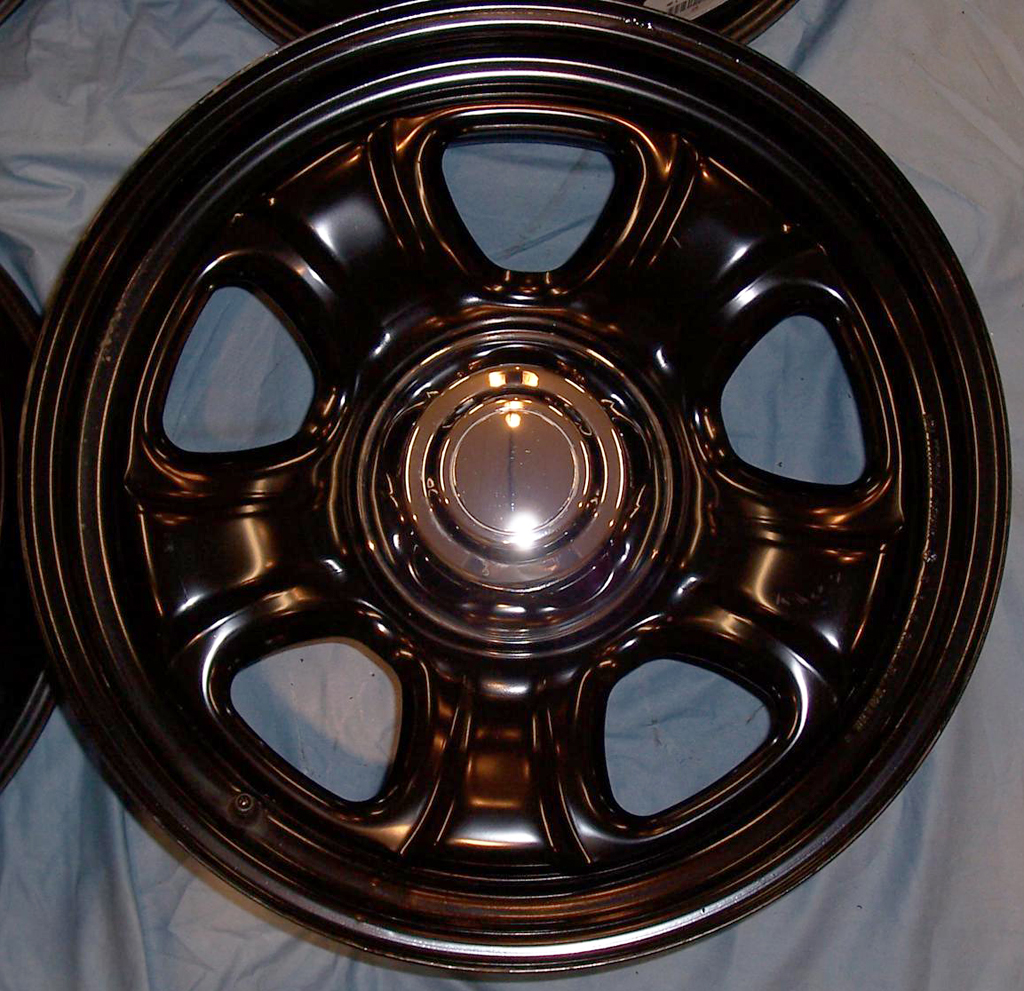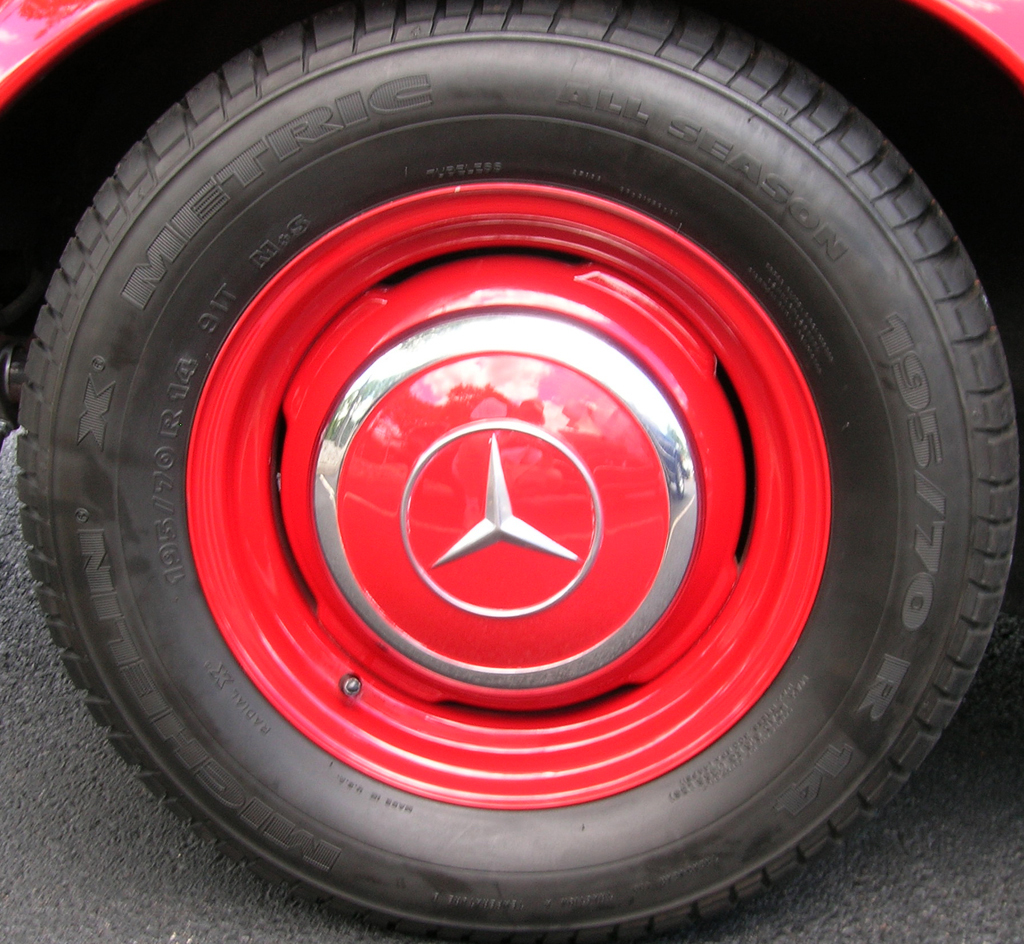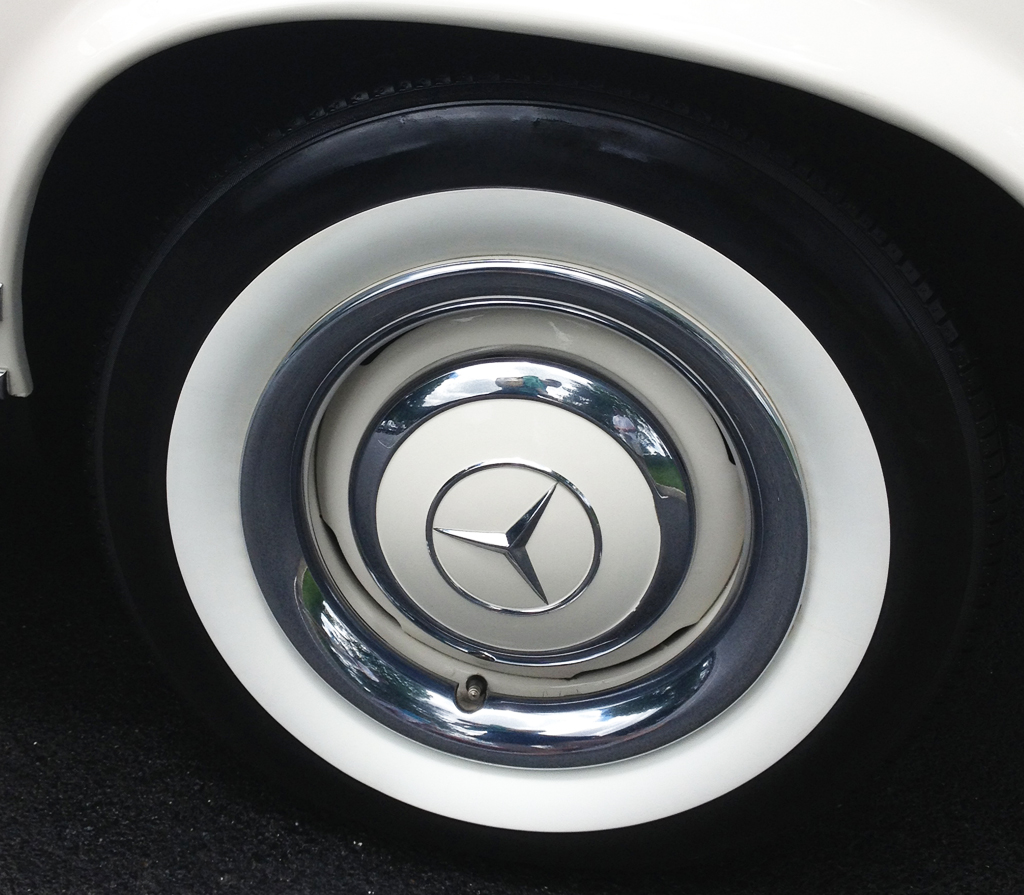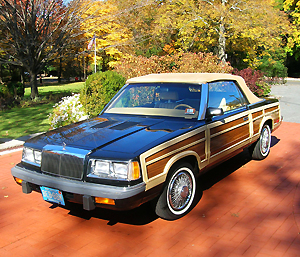
501 Chrysler Town & Country convertibles like this one were made for the 1986 model year. SEE SLIDESHOW AT END OF ARTICLE FOR A PICTORAL TOUR OF 1982-86 LEBARONS
“In convertibles it’s important to remember you’re under a magnifying glass, because everyone notices what you’re doing. It’s no place to pick your nose. You want to look bored almost – give it some ennui” was the advice K.J. Barrett received from her mentor Arnold Gingrich (who founded Esquire Magazine) working as a copywriter after getting her first car, a new ’57 Ford Thunderbird convertible. “It was my dream car and I had taped a picture of one to my desk for motivation until I actually owned one.”
Photo slideshow detailing all LeBaron Town & Country variations is at bottom of article
K.J. practiced Gingrich’s advice in her T-Bird for decades, driving it sparingly in later years until 1986. “With our youngest going to college, I sold it to a gentleman who was going to restore the car. Watching it pull away on a trailer that summer was a sad day in my life. Haven’t seen it since, but I know my T-Bird found a good home.”
At that point during the summer of 1986, K.J. and her husband decided new Chrysler LeBaron Town & Country convertibles they’d noticed on the roads were nicely executed impressions of a classic concept. “My parents once had a ’46 Town & Country convertible and having another one meant a lot, even if the wood was fake”, recalled Barrett. Because the T&C ragtop would be discontinued in the following year’s redesign, finding a dealer with ‘86s left in stock was challenging. She finally did and took delivery of one of the last T&C ragtops in August of 1986.
“This car’s been a real survivor. First winter I had it, I was driving to work through heavy ice and snow. I slid off the road through a wood fence into a cemetery. Somehow I thought there was a steep cliff on the other side of that fence (there was no actual drop at all), so as it was happening I closed my eyes and said to myself ‘Well, this is it – you’re going out of this world listening to Artie Shaw on the stereo. Could be worse’.”
After coming to rest between two rows of tombstones inches away on each side, K.J. climbed out through the window to see an entire stone slab floating on the car’s hood atop a layer of snow. When a mechanic with a towtruck pulled the LeBaron back onto the road, he and K.J. were amazed to see the car hadn’t suffered one scratch, had no fluids leaking, and ran perfectly. She continued on her way to work in the snowfall, and was surprised to still arrive before anyone else did.
She doesn’t plan on selling the car, if for no other reason than it has always been surrounded by a strong force field of good luck. During a visit to a local Chrysler dealer for a recall in 2005, a technician working on it sought her out to say he had worked at the dealership where K.J. had purchased the car in 1986 and remembered prepping her car new, after recognizing the unique alarm keypad he himself had installed on it then.
He also described how, before being sold, a lot attendant had parked the LeBaron on the dealership’s front lawn with the transmission in neutral. As it later rolled unattended onto the six-lane highway in front of the dealership, several cars steered around it without drama. The miracle he witnessed, as the technician tells it, occurred when an oncoming 18-wheeler locked up its brakes attempting to swerve. The trucker narrowly missed hitting the LeBaron with his cab although the trailer end jackknifed into two lampposts and a sign. No injuries were sustained, and the car was recovered from the middle of the highway without a mark.
Over the years on the road, it’s also emerged scratch-free after being sideswiped on the left-front corner in 1989, having a nine-inch-thick tree branch fall on it in 1992, and being involved in a combined rear-then-front impact between two other cars.
“You don’t see ‘80s Chryslers anymore. They haven’t survived the test of time well, but this car’s been great. The biggest challenges keeping it up have been finding a bodyshop willing to deal with the plastic wood to fix minor rust underneath, and locating 1-inch whitewalls. I had to custom-order this size tire, and they were expensive. My son used to be a mechanic himself, and he’s been a big help in fixing things on the car,” says K.J.
After 44,000 miles, the engine starts up and purrs smoothly, giving brisk acceleration with minimal turbo lag. Stiffer front struts equipped on this turbo model create a stiff, almost jarring ride – one K.J. says has always been characteristic of her car. A tight turning radius allows enjoyable driving around town, especially with the leather-wrapped steering wheel in hand. On the interstate, the high final-drive gearing that produces peppy acceleration from a stop results in high revving at speed. Droning noise from the powertrain combines with high wind noise to remind you that you’re piloting a 24-year-old car with engineering roots from 1979.
Sometimes that’s what “personality” in cars is all about.
CHARTING THE YEAR-TO-YEAR CHANGES OF LEBARON TOWN & COUNTRY CONVERTIBLES:
1982
Encouraged by chairman Lee Iacocca, Chrysler created this generation of LeBaron and Dodge 400 convertibles in April 1982 based on the compact, front-wheel-drive “K” car platform introduced for 1981. Converted by Cars & Concepts of Michigan, ‘82s lacked rear side windows or a “wood” trim option. A Town & Country simulated wood package was offered for ’82 station wagons only, but a heavily-contented “Mark Cross” convertible package focused on designer leather interiors.
The ‘82 base engine was an overhead-camshaft 2.2-liter carbureted 4-cylinder producing 84 horsepower. Optional was a 2.6-liter overhead camshaft Mitsubishi 4-cylinder engine of 93 horses.
1983 (1,520 Town & Country convertibles sold)
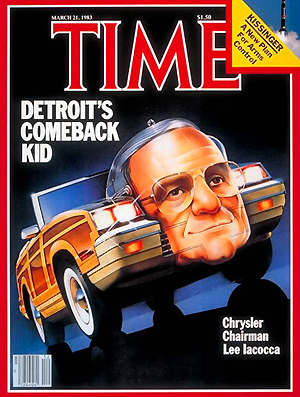
The Time Magazine issue of March 21, 1983 ran a feature on how Chrysler Corporation had paid back their government loans early. Credited with the company’s recovery were chairman Lee Iacocca and popular models such as the K-Car and LeBaron convertible.
As Chrysler Corporation’s finances improved during 1982, a Town & Country convertible for ’83 was finally sanctioned. Town & Country convertibles came standard with Mark Cross leather interior packages and the 1,520 sold made up almost ten percent of all ’83 rag top production.
Town & Country convertibles all featured the larger 2.6-liter Mitsubishi engine (93 horsepower) standard this year.
1984 (1,105 Town & Country convertibles sold)
The Town & Country’s base 2.6-liter 4 cylinder engine received a horsepower upgrade to 101 horsepower. Optional was a newly-introduced turbocharged version of the 2.2-liter 4-cylinder making 140 horsepower.
Digital instrument clusters replaced traditional gauges as standard equipment on Town & Countrys.
All ’84 convertibles gained proper side rear quarter windows, reducing the huge blind spots that plague 1982-83s when the top is up.
Rear windows were now made of glass rather than plastic.
Unchanged up front, all ’84 LeBarons featured a revised rear end with new wraparound taillights of a taller design featuring horizontal trim strips. Steering wheels were redesigned to feature two wider, more padded spokes.
Reportedly, two prototype versions of the Dodge 600 convertible were produced with Town & Country woody appliques and Mark Cross interior identical to the LeBaron. One such vehicle was featured at the Forney Auto Museum in Denver, Colorado (see pictures below).
1985 (595 sold Town & Country convertibles sold)
Engine choices were the same as ’84. The optional turbo 2.2-liter 4-cylinder got a bump to 146 horsepower this year, remaining unchanged through the end of ’86.
Front grilles were updated on LeBarons. While the new grille’s overall shape was unchanged, vertical bars were now split into eight side-by-side sections. (See picture slideshow for a closer look)
1986 – Styling updates, and the final year for Town & Country convertibles (501 sold)
Visibly, LeBarons remained the same until front and rear fascias, headlights, grilles, and taillights were updated for ’86. Sharp corners were rounded for a more aesthetic, aerodynamic appearance.
As mandated by U.S. federal law, ‘86s were equipped with a center mounted brake light mounted atop the trunk lid.
The carbureted 2.6-liter Mitsubishi base engine was dropped this year, replaced by a fuel injected Chrysler-built 2.5-liter 4-cylinder producing 100 horsepower. The optional 2.2-liter turbocharged 4-cylinder remained unchanged from ’85.
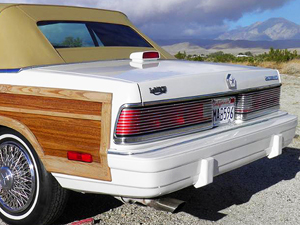 Steadily declining Town & Country sales would make ‘86 the last hurrah for wood-grain soft tops (501 were sold), although the package remained on wagons for two additional years. Four-door LeBarons (unlike coupes and convertibles) didn’t see redesign until after 1988.
Steadily declining Town & Country sales would make ‘86 the last hurrah for wood-grain soft tops (501 were sold), although the package remained on wagons for two additional years. Four-door LeBarons (unlike coupes and convertibles) didn’t see redesign until after 1988.
LeBarons were prone to rust, and finding lucky survivors like K.J.’s in Northern states is challenging. Sought by collectors, T&C convertible values today range from $1,000 to over $10,000 based more on condition than mileage. With the lowest production numbers and design revisions, final-year ‘86s command the highest prices.
CLICK ON ANY OF THE PICTURES BELOW TO SEE FULL SIZE IMAGES. HIT ARROW BUTTONS UNDERNEATH EACH PHOTO TO SCROLL BACK OR FORWARD.
- 501 Chrysler Town & Country convertibles like this one were made for the final 1986 model year.
- 1986 Chrysler LeBaron Town & Country convertible
- LeBaron convertibles were introduced for the 1982 model year, but Town & Country “woodie” ragtops would not debut until the following year.
- Chrysler LeBaron convertibles were introduced late in 1981 as ’82 models. “Reservations are now being taken for spring delivery” as the text quotes. There was no Town & Country version for 1982.
- This promotional picture introduces the 1982 LeBaron Town & Country wagon. Sedans and coupes never got the wood treatment.
- Most LeBaron Town & Country convertibles were equipped with these 14-inch wire wheel covers. They were first introduced in 1982.
- The Mark Cross designer leather interior package was a high-line option on LeBarons during all years. Optional on base convertibles, Mark Cross interiors were standard on all Town & Country convertibles. 1982-84 Mark Cross packages featured this color.
- Original buyers of LeBaron convertibles with Mark Cross leather packages could opt for these special plaques (all Town & Country convertibles were equipped with Mark Cross interiors).
- Before digital instrument clusters arrived for 1984, all LeBaron convertibles featured this instrument cluster through 1983. Earlier digital trip computers had multiple control buttons along the dash, later ones were more streamlined.
- A year after the Town & Country wagon was introduced, a version of the convertible was introduced. Note the lack of rear side windows that were not introduced until the ’84 model year.
- Visible on this 1983 T&C convertible is the trunk-mounted luggage rack that was a popular option on convertibles. Like 1982 tail lights, the ones on ’83s did not wrap around the rear corners.
- This 1983 Chrysler Town & Country ad shows the new ’83 convertible, the wagon introduced the previous year, and a 1949 convertible in the background.
- This photo allows a view of the front of a 1983 LeBaron Town & Country convertible.
- For 1984, LeBaron convertibles received additional rear side windows to reduce blind spots.
- For 1984, LeBarons all received wrap-around rear tail lamp assemblies. Notice the difference between the ’84 model shown here, and the ’83 model shown in an earlier picture.
- From 1984 on, a Turbocharged 4-cylinder engine was optional. These badges adorned front fenders of some of the LeBarons so equipped.
- The Chrysler 2.2-liter turbo engine that became an option on 1984-on LeBarons.
- LeBarons equipped with the 2.2 Turbo engine had these functional air vents on the hood.
- 1984 and 1985 Town & Country convertibles featured this new digital instrument cluster standard.
- Here, a closer look at front bumper, grille, headlights and wood appearances on 1983 and 1984 LeBaron Town & Country convertibles. (Photo: D. Glazz))
- 1985 LeBarons received new front grilles, as seen here. The grille’s overall shape was unchanged, but was now split into eight side-by-side vertical sections.
- For 1985 and 1986, LeBaron convertibles with the Mark Cross interior package (including all T&Cs) had two-tone leather of light and dark tan colors as shown here.
- This 1985 ad with pitchman Ricardo Montalban discusses the merits of the T&C convertible and wagon.
- A 1985 LeBaron convertible brochure picture.
- 1985 Chrysler LeBaron Town & Country convertible rear view. Little had changed from the prior year.
- For 1986, LeBaron front and rear fascias were redesigned. As this picture shows, headlight assemblies, fender corners, and bumpers were rounded for a more aerodynamic look. The shape of wood trim along the front and rear fenders was revised.
- For 1986, aerodynamic revisions to the rear include new, more rounded taillamps, trunklid, and bumper cover. To meet new federally mandated third brake light regulations, a trunk-mounted brake light assembly is fitted as seen here.
- Most 1986 LeBaron Town & Country convertibles were painted black or white, but some were painted bronze as seen here.
- 1986 Chrysler LeBaron Town & Country convertible, side view. The aluminum wheels shown on this car on display at the Chrysler Museum were not a commonly chosen accessory.
- Digital instrument clusters were redesigned for 1986 to look like this. All Town & Country convertibles were equipped with them.
- AM-FM stereo radios with cassette and equalizer were standard on most years of Town & Country convertibles.
- A closer look at the Mark Cross leather interior standard on all 1985-86 LeBaron Town & Country convertibles. (1986 model shown)
- Rear seat view of a 1985-86 LeBaron Town & Country convertible with Mark Cross interior. Unlike 1982-83 models, rear passengers had padded cut-out areas for elbow room.
- Leather-covered center armrests on LeBaron T&C convertibles were embossed with the Mark Cross emblem. (1986 model shown)
- Ricardo Montalban appears in this futuristic 1986 Chrysler LeBaron convertible ad. Lebarons without the wood trim featured bright silver moldings along the rocker panels and around wheel openings.
- A 1986 Chrysler LeBaron convertible brochure picture.
- Window sticker of a typical 1986 Chrysler LeBaron Town & Country convertible.
- Dodge sold a sister version of the LeBaron convertible, named the 400 from 1982-83, then renamed the 600 from 1984-86. Dodge versions were almost identical except for lacking the LeBaron’s stand-up hood ornament, and having a different grille. Notice how closely the “600” trunk badge resembles Mercedes lettering of the time.
- Dodge 600 ES convertibles were equipped the 2.2 turbo engine and 15-inch aluminum wheels. These wheels upgraded from a 4-bolt pattern to a 5-bolt one for 1985 (’86 model shown) and were not available on LeBaron convertibles.
- Dodge 600ES turbo convertibles received slightly different digital instrument clusters and steering wheels.
- Six custom-painted, green 1986 Chrysler LeBaron and Dodge 600 convertibles served as comic relief throughout the 1987 movie “Planes, Trains and Automobiles” starring Steve Martin and John Candy.
- No actual Town & Country convertibles were destroyed during filming because the studio found plain ’86 Dodge 600s and Chrysler LeBarons, painted them green, and then applied the stock wood trim afterward.
- “Gran Detroit Farm & Country Turbo” would be the full name of this film version. Perhaps filmmaker John Hughes selected the same green color as the “Family Truckster” station wagon in Vacation he also produced.
- Special “D” hood badges replaced Chrysler ones on convertibles used in the movie.
- Chrysler insisted that all references to their actual product be removed due to the disasters that befall the actors while in the car. So there are no Chrysler or Dodge logos of any kind – only badges made up by filmmaker John Hughes. “Farm and Country” badging adorns the film vehicles.
- A close observer will notice in some scenes, the movie convertible has rear taillights from an ’86 Dodge 600 rather than a LeBaron.
- After the interior of the car was consumed by fire, Steve Martin and John Candy proceed on in Planes, Trains, and Automobiles.
- Here, stunt doubles prepare to do a driving scene.
- LeBaron two-door coupes and convertibles were redesigned for 1987 as shown here. The T & C ragtop did not carry over to the new design.
- While LeBaron convertibles and coupes were redesigned for 1987, sedans and wagons remained unchanged through 1988.
- A final-year 1988 Chrysler LeBaron Town & Country wagon. The T&C name would resurface in later years on minivans only.
- According to the Forney Museum in Denver, Colorado where this car was on display, two 1984 Dodge 600 woodies were built as prototypes by Chrysler. While we can’t confirm if this is true, it’s enjoyable to see this version.
- Right front view of a 1984 Dodge 600 convertible woodie prototype.
- A rear angle view of the “prototype” 1984 Dodge 600 woody convertible.
- Rear of the “prototype” 1984 Dodge 600 woody convertible.
- Interior of the “prototype” 1984 Dodge 600 woody convertible.
- This Chrysler factory diagram shows the structural reinforcements made for the convertible model.

